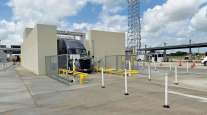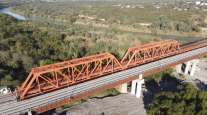Staff Reporter
GSA’s Border Facility Renovations Projected to Thin Congestion at Crossings

The General Services Administration is conducting a series of border facility renovations and overseeing related interstate closures at land ports of entry across the U.S.-Mexico border.
Most recently, portions of Interstate 5 and I-805 that run south of state Route 905 in California were closed from Sept. 23-25. The 45-hour southbound traffic closure was due to expansion work at the San Ysidro Land Port of Entry. The San Ysidro port is located on the U.S.-Mexico border in San Diego County.
During the closure, GSA directed vehicles traveling south to Mexico to use the Otay Mesa Port, which is about 9 miles east of San Ysidro. The Otay Mesa Port, located along state Route 905 in San Diego, cleared 899,336 trucks and more than 7 million personal vehicles in 2016, according to the Bureau of Transportation Statistics.
The San Ysidro project ultimately will realign and expand I-5 from five lanes to 10, according to GSA spokesman Andra Higgs. The agency will also construct 10 new southbound inspection booths, a southbound secondary inspection facility, eight additional northbound vehicle lanes and 15 northbound inspection booths.
Although San Ysidro does not process trucks, these expansion projects will allow for more passenger vehicles to move through the station, thereby alleviating some of the personal-vehicle traffic that trucks compete with at stations that process both commercial and noncommercial vehicles.
“GSA’s construction work is about improving the operational efficiency, security and safety for cross-border travelers and federal agencies at the San Ysidro LPOE,” Higgs said. “By doing so, this will create alternatives for noncommercial vehicles and pedestrians to cross the border thereby, short and long term, providing options for the traveling public, which has the potential to lower the number of noncommerical vehicles on roadways leading to Otay Mesa and Calexico LPOEs, where commercial freight crossings occur on both sides of the border.”
President Donald Trump ran his campaign on the promise of stringent border security. In addition to Otay Mesa, his budget plan for fiscal 2018 includes funding for modernization work at Alexandria Bay, N.Y., and the San Luis Port of Entry, which is located at the western edge of Arizona, less than 3 miles from the California border. GSA will start a study for its work in Arizona later this fall, Higgs said.
The agency also is overseeing construction of an inspection facility for personal vehicles at the Calexico West Port of Entry, which links the Mexican state of Baja California to Imperial County, Calif., home of a thriving agriculture industry. According to the Imperial County Farm Bureau, Imperial Valley is one of California’s top five producers of spinach, potatoes, cauliflower, broccoli and onions.
Most of GSA’s projects involve lane expansions and adding capacity to federal inspection agencies’ processing facilities. However, Higgs said that GSA is participating in a study to look at various “innovative concepts”, including interchangeable lanes that can be designated to accommodate trucks and passenger vehicles, depending on traffic surges.
“Generally, GSA is expanding the number of lanes and providing additional capacity in our projects. GSA is participating in a study looking at various innovative concepts including interchangeable lanes,” Higgs said. “Much of the improved efficiency at our LPOE projects comes from the installation of infrastructure to support [U.S. Customs and Border Protection] federal inspection agency technologies. GSA works closely with CBP to ensure our facilities provide the capacity to accommodate CBP’s changing inspection technology.”
Interchangeable lanes will feature prominently at Otay Mesa East, a border crossing station that GSA and CBP are building in a partnership with the California Department of Transportation and the San Diego Association of Governments. Otay Mesa East will be located 2 miles from the existing Otay Mesa Port.
“In the past, ports of entry were planned as islands without taking into consideration the transportation network,” said Mario Orso, trade corridor director of Caltrans. “Otay Mesa East is developing roadway and port of entry jointly.”




